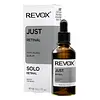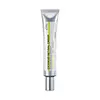What's inside
What's inside
 Key Ingredients
Key Ingredients

 Benefits
Benefits

 Concerns
Concerns

 Ingredients Side-by-side
Ingredients Side-by-side

Water
Skin ConditioningHydrolyzed Elastin
EmollientPanthenol
Skin ConditioningPropylene Glycol
HumectantGlycerin
HumectantPEG-40 Hydrogenated Castor Oil
EmulsifyingPhospholipids
Skin ConditioningCaprylic/Capric Glycerides
EmollientAscorbic Acid
AntioxidantRetinal
Skin ConditioningPhenoxyethanol
PreservativeHydroxyethylcellulose
Emulsion StabilisingSodium PCA
HumectantWheat Amino Acids
Skin ConditioningSodium Hyaluronate
HumectantHydroxyproline
Skin ConditioningEthylhexylglycerin
Skin ConditioningPPG-1-PEG-9 Lauryl Glycol Ether
EmulsifyingDisodium EDTA
Citric Acid
BufferingWater, Hydrolyzed Elastin, Panthenol, Propylene Glycol, Glycerin, PEG-40 Hydrogenated Castor Oil, Phospholipids, Caprylic/Capric Glycerides, Ascorbic Acid, Retinal, Phenoxyethanol, Hydroxyethylcellulose, Sodium PCA, Wheat Amino Acids, Sodium Hyaluronate, Hydroxyproline, Ethylhexylglycerin, PPG-1-PEG-9 Lauryl Glycol Ether, Disodium EDTA, Citric Acid
Water
Skin ConditioningCaprylic/Capric Triglyceride
MaskingEthylhexyl Palmitate
EmollientGlycerin
HumectantButyrospermum Parkii Butter
Skin ConditioningDicaprylyl Carbonate
EmollientCaprylic/Capric/Myristic/Stearic Triglyceride
EmollientNiacinamide
SmoothingPentylene Glycol
Skin ConditioningHydrogenated Polydecene
EmollientPhenyl Trimethicone
Skin Conditioning1,2-Hexanediol
Skin ConditioningMacadamia Ternifolia Seed Oil
EmollientRetinal
Skin ConditioningMelia Azadirachta Flower Extract
Skin ConditioningMelia Azadirachta Leaf Extract
Skin ConditioningCurcuma Longa Root Extract
MaskingOcimum Sanctum Leaf Extract
Skin ConditioningCorallina Officinalis Extract
Skin ConditioningHydrolyzed Hyaluronic Acid
HumectantCentella Asiatica Extract
CleansingGlycine Soja Oil
EmollientPinus Pinaster Bark Extract
AntioxidantPolyglyceryl-6 Stearate
EmollientSynthetic Beeswax
Emulsion StabilisingCetearyl Olivate
Sorbitan Olivate
EmulsifyingSilica
AbrasiveButylene Glycol
HumectantPanthenol
Skin ConditioningSorbitan Stearate
EmulsifyingHydrogenated Lecithin
EmulsifyingHydroxyacetophenone
AntioxidantAmmonium Acryloyldimethyltaurate/Vp Copolymer
Pentaerythrityl Distearate
EmulsifyingSodium Acrylate/Sodium Acryloyldimethyl Taurate Copolymer
Emulsion StabilisingPalmitic Acid
EmollientPolyisobutene
Stearic Acid
CleansingPolyglyceryl-6 Behenate
Emulsion StabilisingCholesterol
EmollientBakuchiol
AntimicrobialBrassica Campestris Sterols
EmollientAdenosine
Skin ConditioningCeteth-3
EmulsifyingCeteth-5
EmulsifyingDipotassium Glycyrrhizate
HumectantTocopherol
AntioxidantAluminum/Magnesium Hydroxide Stearate
Emulsion StabilisingTocopheryl Acetate
AntioxidantSodium Phytate
Caprylyl/Capryl Glucoside
CleansingPotassium Cetyl Phosphate
EmulsifyingSorbitan Oleate
EmulsifyingPentaerythrityl Tetra-Di-T-Butyl Hydroxyhydrocinnamate
AntioxidantAllantoin
Skin ConditioningMadecassoside
AntioxidantCeramide NP
Skin ConditioningRetinol
Skin ConditioningStearyl Alcohol
EmollientCetyl Alcohol
EmollientMyristyl Alcohol
EmollientLauryl Alcohol
EmollientDisodium EDTA
PEG-5 Rapeseed Sterol
CleansingWater, Caprylic/Capric Triglyceride, Ethylhexyl Palmitate, Glycerin, Butyrospermum Parkii Butter, Dicaprylyl Carbonate, Caprylic/Capric/Myristic/Stearic Triglyceride, Niacinamide, Pentylene Glycol, Hydrogenated Polydecene, Phenyl Trimethicone, 1,2-Hexanediol, Macadamia Ternifolia Seed Oil, Retinal, Melia Azadirachta Flower Extract, Melia Azadirachta Leaf Extract, Curcuma Longa Root Extract, Ocimum Sanctum Leaf Extract, Corallina Officinalis Extract, Hydrolyzed Hyaluronic Acid, Centella Asiatica Extract, Glycine Soja Oil, Pinus Pinaster Bark Extract, Polyglyceryl-6 Stearate, Synthetic Beeswax, Cetearyl Olivate, Sorbitan Olivate, Silica, Butylene Glycol, Panthenol, Sorbitan Stearate, Hydrogenated Lecithin, Hydroxyacetophenone, Ammonium Acryloyldimethyltaurate/Vp Copolymer, Pentaerythrityl Distearate, Sodium Acrylate/Sodium Acryloyldimethyl Taurate Copolymer, Palmitic Acid, Polyisobutene, Stearic Acid, Polyglyceryl-6 Behenate, Cholesterol, Bakuchiol, Brassica Campestris Sterols, Adenosine, Ceteth-3, Ceteth-5, Dipotassium Glycyrrhizate, Tocopherol, Aluminum/Magnesium Hydroxide Stearate, Tocopheryl Acetate, Sodium Phytate, Caprylyl/Capryl Glucoside, Potassium Cetyl Phosphate, Sorbitan Oleate, Pentaerythrityl Tetra-Di-T-Butyl Hydroxyhydrocinnamate, Allantoin, Madecassoside, Ceramide NP, Retinol, Stearyl Alcohol, Cetyl Alcohol, Myristyl Alcohol, Lauryl Alcohol, Disodium EDTA, PEG-5 Rapeseed Sterol
 Reviews
Reviews

Ingredients Explained
These ingredients are found in both products.
Ingredients higher up in an ingredient list are typically present in a larger amount.
Disodium EDTA plays a role in making products more stable by aiding other preservatives.
It is a chelating agent, meaning it neutralizes metal ions that may be found in a product.
Disodium EDTA is a salt of edetic acid and is found to be safe in cosmetic ingredients.
Learn more about Disodium EDTAGlycerin is already naturally found in your skin. It helps moisturize and protect your skin.
A study from 2016 found glycerin to be more effective as a humectant than AHAs and hyaluronic acid.
As a humectant, it helps the skin stay hydrated by pulling moisture to your skin. The low molecular weight of glycerin allows it to pull moisture into the deeper layers of your skin.
Hydrated skin improves your skin barrier; Your skin barrier helps protect against irritants and bacteria.
Glycerin has also been found to have antimicrobial and antiviral properties. Due to these properties, glycerin is often used in wound and burn treatments.
In cosmetics, glycerin is usually derived from plants such as soybean or palm. However, it can also be sourced from animals, such as tallow or animal fat.
This ingredient is organic, colorless, odorless, and non-toxic.
Glycerin is the name for this ingredient in American English. British English uses Glycerol/Glycerine.
Learn more about GlycerinPanthenol is a common ingredient that helps hydrate and soothe the skin. It is found naturally in our skin and hair.
There are two forms of panthenol: D and L.
D-panthenol is also known as dexpanthenol. Most cosmetics use dexpanthenol or a mixture of D and L-panthenol.
Panthenol is famous due to its ability to go deeper into the skin's layers. Using this ingredient has numerous pros (and no cons):
Like hyaluronic acid, panthenol is a humectant. Humectants are able to bind and hold large amounts of water to keep skin hydrated.
This ingredient works well for wound healing. It works by increasing tissue in the wound and helps close open wounds.
Once oxidized, panthenol converts to pantothenic acid. Panthothenic acid is found in all living cells.
This ingredient is also referred to as pro-vitamin B5.
Learn more about PanthenolRetinal is a form of retinoid. Retinoids are the gold-standard class of anti-aging ingredients.
Retinal has many benefits as other retinoids: improve skin texture, reduce large pores, reduce the effects of aging, reduce the visibility of dark spots, heal scars, and fight acne.
Studies show retinal may work at a faster rate than retinol due to its structure.
All retinoids have to be converted into retinoic acid before starting to work. Some retinoids take several steps of conversion before binding. Retinal is only one step away, making it more potent.
Like other retinoids, retinal may be irritating. It is best to ease into using this ingredient frequently.
Using the 'ramp up' method, start by using retinol once a week. This gives your skin time to adjust and decrease irritation. Once you feel ready, you can slowly increase the frequency of retinol use.
Using retinoids will increase sun-sensitivity in the first few weeks of use. Though studies show retinoids increase your skin's natural SPF with continuous use, it is best to always wear sunscreen and sun-protection.
Learn more about RetinalWater. It's the most common cosmetic ingredient of all. You'll usually see it at the top of ingredient lists, meaning that it makes up the largest part of the product.
So why is it so popular? Water most often acts as a solvent - this means that it helps dissolve other ingredients into the formulation.
You'll also recognize water as that liquid we all need to stay alive. If you see this, drink a glass of water. Stay hydrated!
Learn more about Water